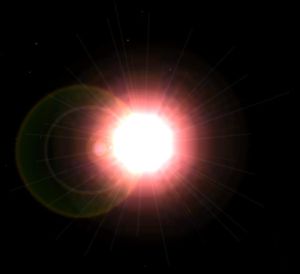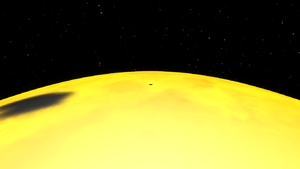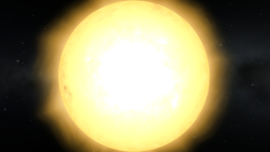Difference between revisions of "Kerbol/th"
m (thai lang category) |
|||
| (2 intermediate revisions by 2 users not shown) | |||
| Line 5: | Line 5: | ||
“Kerbol” เป็นคำประสมที่แฟนสร้างขึ้นมาระหว่าง “Kerbal” และ “Sol” — ชื่อลาตินของ[[w:th:Sun|ดวงอาทิตย์]]ในชีวิตจริง ก่อน{{version|0.11|เวอร์ชั่น}}<sup>(en)</sup>, ซึ่งแนะนำวัตถุสำหรับดาวผู้ปกครองของ KSP และ[[Map view|แผนที่มุมมอง]]วงโคจรwhere it was explicitly named, it was an unnamed directional light source at infinite distance. Fans on the KSP forums invented and popularized the name, and the term "Kerbol System" was used in the official 1.2 release post and the first issue of "The Kerbol Cronicles" magazine released before v.1.3. It is however extremely important to note that the celestial body is called "The Sun" in the english game, and "Sun" in the game files. There is no such thing as Kerbol outside of the community forums and wiki. | “Kerbol” เป็นคำประสมที่แฟนสร้างขึ้นมาระหว่าง “Kerbal” และ “Sol” — ชื่อลาตินของ[[w:th:Sun|ดวงอาทิตย์]]ในชีวิตจริง ก่อน{{version|0.11|เวอร์ชั่น}}<sup>(en)</sup>, ซึ่งแนะนำวัตถุสำหรับดาวผู้ปกครองของ KSP และ[[Map view|แผนที่มุมมอง]]วงโคจรwhere it was explicitly named, it was an unnamed directional light source at infinite distance. Fans on the KSP forums invented and popularized the name, and the term "Kerbol System" was used in the official 1.2 release post and the first issue of "The Kerbol Cronicles" magazine released before v.1.3. It is however extremely important to note that the celestial body is called "The Sun" in the english game, and "Sun" in the game files. There is no such thing as Kerbol outside of the community forums and wiki. | ||
| − | == | + | == คำอธิบายในเกม == |
{{Quote | {{Quote | ||
| Line 11: | Line 11: | ||
|[[Kerbal Astronomical Society]]}} | |[[Kerbal Astronomical Society]]}} | ||
| − | == | + | == โคจรรอบ Kerbol == |
Escaping the SOI of any other body will place an object in orbit around Kerbol. This will give a [[Science]] situation of being in space high over Kerbol until an altitude less than 1,000 Mm is reached. Low orbit can be reached by using a standard [[Tutorial: Advanced Orbiting#Hohmann transfer|Hohmann transfer]]; from [[Kerbin]]'s orbit this requires about 8 km/s of change-in-velocity (Δv). The more efficient way to reach low Kerbol orbit, at the expense of drastically increased flight time, is to use a [[Tutorial: Advanced Orbiting#Bi-elliptical transfer|bi-elliptical transfer]]. With a sufficiently-distant apoapsis, the required Δv to “sundive” from Kerbin orbit can be reduced to under 4 km/s. | Escaping the SOI of any other body will place an object in orbit around Kerbol. This will give a [[Science]] situation of being in space high over Kerbol until an altitude less than 1,000 Mm is reached. Low orbit can be reached by using a standard [[Tutorial: Advanced Orbiting#Hohmann transfer|Hohmann transfer]]; from [[Kerbin]]'s orbit this requires about 8 km/s of change-in-velocity (Δv). The more efficient way to reach low Kerbol orbit, at the expense of drastically increased flight time, is to use a [[Tutorial: Advanced Orbiting#Bi-elliptical transfer|bi-elliptical transfer]]. With a sufficiently-distant apoapsis, the required Δv to “sundive” from Kerbin orbit can be reduced to under 4 km/s. | ||
| Line 18: | Line 18: | ||
The [[sphere of influence]] (SOI) of Kerbol is infinite, making Kerbol inescapable. Thus, achieving gravitation-free flight is impossible. With a powerful enough ship, it is possible to get to the point where the info tab will display the craft's situation as “escaping” Kerbol. The end of the patched conics path plotted by the game can be reached, at which point the spacecraft begins drawing a course behind it. But the actual escape never occurs. Presumably, this state would continue indefinitely, as the time required to find out what would happen would take several years real-time even at maximum time acceleration. | The [[sphere of influence]] (SOI) of Kerbol is infinite, making Kerbol inescapable. Thus, achieving gravitation-free flight is impossible. With a powerful enough ship, it is possible to get to the point where the info tab will display the craft's situation as “escaping” Kerbol. The end of the patched conics path plotted by the game can be reached, at which point the spacecraft begins drawing a course behind it. But the actual escape never occurs. Presumably, this state would continue indefinitely, as the time required to find out what would happen would take several years real-time even at maximum time acceleration. | ||
| − | === | + | === การลงจอด === |
It's impossible to land on the Sun, even with "Ignore max temperature" [[cheat]]s enabled. Any objects are destroyed at an altitude below -250 m, which shows in the end flight dialog as "crashed into the surface of the sun" or similar, rather than ever landing. | It's impossible to land on the Sun, even with "Ignore max temperature" [[cheat]]s enabled. Any objects are destroyed at an altitude below -250 m, which shows in the end flight dialog as "crashed into the surface of the sun" or similar, rather than ever landing. | ||
| Line 84: | Line 84: | ||
{{Celestial Bodies}} | {{Celestial Bodies}} | ||
| − | [[Category:Celestials]] | + | [[Category:Celestials/th]] |
| + | [[Category:Thai Language pages]] | ||
Latest revision as of 01:29, 25 November 2021
| Kerbol | ||
| Kerbol as seen from orbit. | ||
| Star | ||
| Physical Characteristics | ||
| Equatorial radius | 261 600 000 m | |
| Equatorial circumference | 1 643 681 276 m | |
| Surface area | 8.5997404×1017 m2 | |
| Mass | 1.7565459×1028 kg | |
| Standard gravitational parameter | 1.1723328×1018 m3/s2 | |
| Density | 234.23818 kg/m3 | |
| Surface gravity | 17.1 m/s2 (1.747 g) | |
| Escape velocity | 94 672.01 m/s | |
| Sidereal rotation period | 432 000.00 s | |
| 20 d 0 h 0 m 0 s | ||
| Sidereal rotational velocity | 3 804.8 m/s | |
| Synchronous orbit | 1 508 045.29 km | |
| Sphere of influence | ∞ | |
| Atmospheric Characteristics | ||
| Atmosphere present | Yes | |
| Atmospheric pressure | 16.0000 kPa | |
| 0.157908 atm | ||
| Atmospheric height | 600 000 m | |
| 1.6×10-7 atm | ||
| Temperaturemin | 3741.80 °C 4014.95 K | |
| Temperaturemax | 9348.05 °C 9621.2 K | |
| Oxygen present | No | |
| Scientific multiplier | ||
| Surface | N/A | |
| Splashed | N/A | |
| Lower atmosphere | 1 | |
| Upper atmosphere | 1 | |
| Near space | 11 | |
| Outer space | 2 | |
| Recovery | 4 | |
The Sun (เป็นที่รู้จักกันในชื่อ Kerbol) คือดาวฤกษ์แม่ของระบบดาวเคราะห์ใน KSP, นิยมเรียกเป็นระบบ Kerbol ณ เวอร์ชั่น 1.3.0, 5 ดาว: Moho(en), Eve(en), Kerbin, Duna(en) และ Jool(en) และ 2 ดาวเคราะห์แคระ Dres(en) และ Eeloo(en) โคจรรอบมัน. Kerbol มีขนาดใหญ่มากโดยมีมวลเป็น 99.97% ของระบบ Kerbol ซึ่งคล้ายกับดวงอาทิตย์ของเราโดยมีมวลเป็น 99.86% ในระบบสุริยะที่โลกเราอยู่
“Kerbol” เป็นคำประสมที่แฟนสร้างขึ้นมาระหว่าง “Kerbal” และ “Sol” — ชื่อลาตินของดวงอาทิตย์ในชีวิตจริง ก่อนเวอร์ชั่น 0.11(en), ซึ่งแนะนำวัตถุสำหรับดาวผู้ปกครองของ KSP และแผนที่มุมมองวงโคจรwhere it was explicitly named, it was an unnamed directional light source at infinite distance. Fans on the KSP forums invented and popularized the name, and the term "Kerbol System" was used in the official 1.2 release post and the first issue of "The Kerbol Cronicles" magazine released before v.1.3. It is however extremely important to note that the celestial body is called "The Sun" in the english game, and "Sun" in the game files. There is no such thing as Kerbol outside of the community forums and wiki.
Contents
คำอธิบายในเกม
| “ | The Sun is the most well known object in the daytime sky. Scientists have noted a particular burning sensation and potential loss of vision if it is stared at for long periods of time. This is especially important to keep in mind considering the effect shiny objects have on the average Kerbal. | ” |
โคจรรอบ Kerbol
Escaping the SOI of any other body will place an object in orbit around Kerbol. This will give a Science situation of being in space high over Kerbol until an altitude less than 1,000 Mm is reached. Low orbit can be reached by using a standard Hohmann transfer; from Kerbin's orbit this requires about 8 km/s of change-in-velocity (Δv). The more efficient way to reach low Kerbol orbit, at the expense of drastically increased flight time, is to use a bi-elliptical transfer. With a sufficiently-distant apoapsis, the required Δv to “sundive” from Kerbin orbit can be reduced to under 4 km/s.
Previously the closest sustained altitude was 1,340 m, but now bodies emit radiation which heats parts and overheats parts before it could reach the atmosphere. The heating varies on the surface area it shines and part specific heat. Using parts with higher maximum temperature reduces the chance of overheating, making inflatable heat shield a good choice to shield your delicate parts from heat. This imposes a challenge where the objective is to get as close to sun as possible while surviving.
The sphere of influence (SOI) of Kerbol is infinite, making Kerbol inescapable. Thus, achieving gravitation-free flight is impossible. With a powerful enough ship, it is possible to get to the point where the info tab will display the craft's situation as “escaping” Kerbol. The end of the patched conics path plotted by the game can be reached, at which point the spacecraft begins drawing a course behind it. But the actual escape never occurs. Presumably, this state would continue indefinitely, as the time required to find out what would happen would take several years real-time even at maximum time acceleration.
การลงจอด
It's impossible to land on the Sun, even with "Ignore max temperature" cheats enabled. Any objects are destroyed at an altitude below -250 m, which shows in the end flight dialog as "crashed into the surface of the sun" or similar, rather than ever landing.
One can attempt to place edited parts on the surface, but they bounce erratically at a few hundred to a few thousand meters per second if they do not explode.
Temperature and Luminosity
Kerbol's visible surface, its photosphere, has a temperature of 5840 K. This temperature, along with the the star's yellow color, suggests that Kerbol is a Class G main-sequence star. Above the photosphere is a thin and hot atmosphere that is analogous to a chromosphere. The chromosphere extends to a height of 600 km and has at its base a pressure of 16 kPa. The temperature of the chromosphere decreases with increasing altitude until reaching a minimum of 4000 K at a height of 50 km. Above 50 km the temperature increases with increasing altitude. The maximum temperature of 10,000 K is reached at the atmosphere's extreme upper limit.
Based on its given size and temperature, Kerbol’s luminosity would be 56.7 yottawatts, however this is contradicted by other in-game physical parameters. The value of the solar constant at Kerbin is 1360 W/m2, which implies a solar luminosity of 3.16 yottawatts (0.008 Solar luminosities) and a surface temperature of 2840 K. These values are consistent with a Class M red dwarf.
Physical appearance
The equatorial radius of the Sun is almost four times than that of Jupiter and 43.6 times larger than Jool's, the largest planet currently known. Kerbol has the yellow color of a Class G main-sequence star and its absolute bolometric magnitude is approximately +10. If close enough, one can see that the dark spots are indented.
The “corona” surrounding Kerbol is not the actual size of the sun as it appears. It will shrink and grow relative to the location of the viewpoint, just as the size of Kerbol does normally. However, it won't shrink past a certain point, and if the sun is viewed from a far enough point, the corona is still very visible. This is apparent when using camera or telescope mods that remove the corona and show Kerbol's true size, which is usually much smaller than the corona appears.
Past appearances

version 0.7.3 introduced the parent star of Kerbin as a slightly red-tinted directional light (with lots of lens flare) in the skybox at infinite distance, thus impossible to reach.

Reference Frames
| Time warp | Minimum Altitude |
|---|---|
| 1× | Any |
| 5× | 3 270 000 m |
| 10× | 3 270 000 m |
| 50× | 6 540 000 m |
| 100× | 13 080 000 m |
| 1 000× | 26 160 000 m |
| 10 000× | 52 320 000 m |
| 100 000× | 65 400 000 m |
All Kerbol orbits are in an inertial reference frame. In the old demo, getting close enough to experience the lower maximum time warps results in Deep Space Kraken attacks.
Trivia
- The name “Kerbol” was created by forum members and never appears in the game. Officially, the star is simply referred to as “the Sun," though the lead developer mentioned that its name could change once the need to differentiate it from other stars arises.
- "Kerbol" is likely a portmanteau of "kerbal" and "sol", the Latin name of the Sun.
- The Sun has just under twice the surface gravity of Kerbin, thus only slightly more than Eve's.
- The Kerbal Sun is not a realistic analogue of our Real Sun.
- The Mun is larger and closer to Kerbin than Moon to Earth, and thus in order to make eclipses work right, the Sun was made large enough to fit.
Real-world comparison
While otherwise analogous to our own real-life Sun, Kerbol has 1/113th the mass and a 1/3rd its radius. Kerbol's other attributes can be used to derive the following statistics: it has a luminosity of approximately 3 yottawatts based on the solar constant at Kerbin; a defined surface temperature of 5840 K (that of a Class G star), but a temperature less than 3000 K based on its size and luminosity (that of a Class M star); the radius of a red dwarf; and the mass of a sub-brown dwarf. Such a star in real life would be on the limits of Hydrostatic equilibrium and it's small size would mean it would only generate as much heat as a red dwarf. However, many astrophysical properties in KSP are effectively scaled down for gameplay.
It's real-life counterpart according to its size and mass would be 2MASS J0523-1403, the smallest star in existence.
Gallery
Up close the glow becomes evidently ennagonal.
Changes
- Changed displayName to The Sun, removed useTheInName = true feature.
- Added atmosphere
- Art pass.
- Actual model added, new sprite/flare effect, size changed.
- Added solid surface (featureless invisible plateau ~4500–4700 km above nominal radius).
- Added Gravity, nominal radius of 65,400 km.
- Made it possible to reach Kerbol.
- Initial Release.





